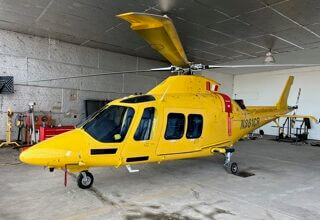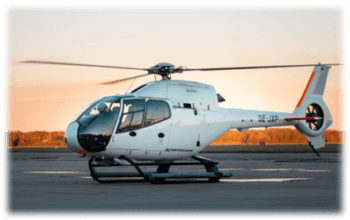Estimated reading time 9 minutes, 59 seconds.
With admissions to intensive care units (ICUs) overwhelming Manitoba hospitals in early June, a newly acquired Royal Canadian Air Force (RCAF) capability has been vital to airlifting critically ill, COVID-infected patients to hospitals in other provinces.
Over seven flights this month, the RCAF has transported nine patients from Manitoba to Ontario and Alberta within its Aeromedical Biocontainment Evacuation System (ABES), a sea container-like unit on board a CC-130J Hercules.

Acquired in mid-2020, the ABES is part of a $7.3 million investment in three specialized biocontainment transport systems operated by the Aeromedical Evacuation Flight (AEF) at 8 Wing Trenton, Ontario. The other two are an Aeromedical Single Isolation Biocontainment Unit (ASIBU), or EpiShuttle, that keeps a patient isolated in a plastic bubble-like container while still allowing medical personnel access to provide treatment; and a Disposable Isolation Single Biocontainment Unit, a one-time-use version of the ASIBU.
“This was done to make sure we could take care of [Canadian Armed Forces (CAF) personnel] with COVID or other infectious diseases,” explained LCol Richard Hannah, 1 Canadian Air Division Flight Surgeon to whom the AEF reports.
The airlift of civilian patients to relieve overstressed ICUs, however, has been among the first uses of the ABES.
The ABSIU and disposal unit can fit into almost any aircraft in the RCAF inventory, including the CC-144 Challenger jet and any of the tactical aviation, search-and-rescue or maritime helicopters. The ABES was designed and built specifically for the CC-177 Globemaster and CC-130J Hercules.
The container was first used to transport a COVID-infected CAF member and four of his family members from an international deployment, but its recent employment has been as part of Task Force Bison, a standby response under Operation Laser to support Manitoba health services.
Op Laser is the ongoing CAF global response to the pandemic. The RCAF has also deployed an Air Task Force under Operation Vector to transport CAF medical personnel and other government officials in support of vaccinations in remote First Nations communities across northern Manitoba.

Over a number of days, aircrews with 436 Transport Squadron conducted five flights with the CC-130J, carrying single patients to Ontario, and two flights with multiple patients to Ottawa and Calgary.
“That is pushing it close to the limit of what it was designed to do,” said Hannah. “We didn’t want to put four patients in the ABES all at once the first time out the gate. Two was a good number for how ill those patients were. You also need a lot of medical staff to care for them.”
The hunt for a safe way to transport infectious patients has been ongoing since 2014 when the CAF deployed a medical unit to Sierra Leone to assist in the fight against a devasting Ebola virus outbreak in West Africa. How to bring home a potentially infected and highly contagious team member quickly became a priority. The interim solution, on standby if needed, was a military ambulance in the back of a CC-177.
In 2017, the CAF began the process of acquiring a more permanent solution developed in the United States, but problems detected with the system led to the project’s cancellation. While the Air Force avoided making “a bad buy,” the process left the RCAF “back at square one trying to procure another biocontainment device,” Hannah acknowledged.
As COVID-19 began spreading across the globe in early 2020, the effort renewed with some urgency to secure a system that could protect aircrews and aircraft from patients with a contagious disease. The key criterium was flexibility, said Hannah. While the container would have to fit on a larger aircraft for global transport and between major centers in Canada, it would also need to work in a smaller airframe like the Hercules, landing and taking off on shorter runways in remote communities.

Working with the winning bidder, Knight Aerospace of San Antonio, Texas, the RCAF procured an ABES configurable for up to four patient beds or as many as 16 passengers, or “any combination of the two,” said Hannah. “As you add seats, you lose beds, and vice versa.”
The container is able to maintain negative pressure throughout a long flight and uses an advanced air filtration system to prevent contamination of the aircraft. A vestibule inside the container allows medical teams to change into and out of protective equipment and decontaminate before exiting the system.
“The ABES is phenomenal, especially for the really sick critical care patients,” he said. “The medical crews that I speak with are all very happy with it. Like any new equipment, there are maybe little things they would change – making the bed slightly lower or changing the sound the phone makes because it is similar to the sound of an alarm on a ventilator – but functionally it works great.”
While a typical medical team would include a critical care nurse and critical care physician for each patient, as well as support staff such as a general duty nurse and, in some cases, a general duty physician, the team will be tailored to the condition and number of patients and the length of the flight, Hannah observed. “We’ll make sure we have the right team with the right qualifications and the right experience.”
The AEF maintains a year-round, short-notice response for medical evacuations, ready to deploy within 12 to 72 hours. But Task Force Bison is on standby to move in as few as four hours, if necessary, he said. “For us, it is not really a change in our [overall] posture. If we need the ABES, we would use it.”
The ABES currently takes “several hours” to install in the back of an aircraft, but that time requirement will likely decrease as loadmasters become more familiar with the new system. After each mission, the CC-130 has returned to Trenton for deep cleaning – “we clean the ABES just like a hospital room.”
Though it is labeled a biocontainment device, Hannah is now thinking of it as “an aeromedical evacuation device that happens to do biocontainment. It is far more comfortable than operating in the back of a cargo aircraft. It certainly helps with regulating temperature and noise and vibration. It is like a hospital room in the back of the airplane.”
Even if patients are not infectious, the ABES might still be the best method of transporting them, he stressed. “I don’t think this thing is going to sit on a shelf somewhere waiting for the next pandemic. My intention would be to use it for any mission that we are going to fly a patient on a C-17 [or] CC-130.”








